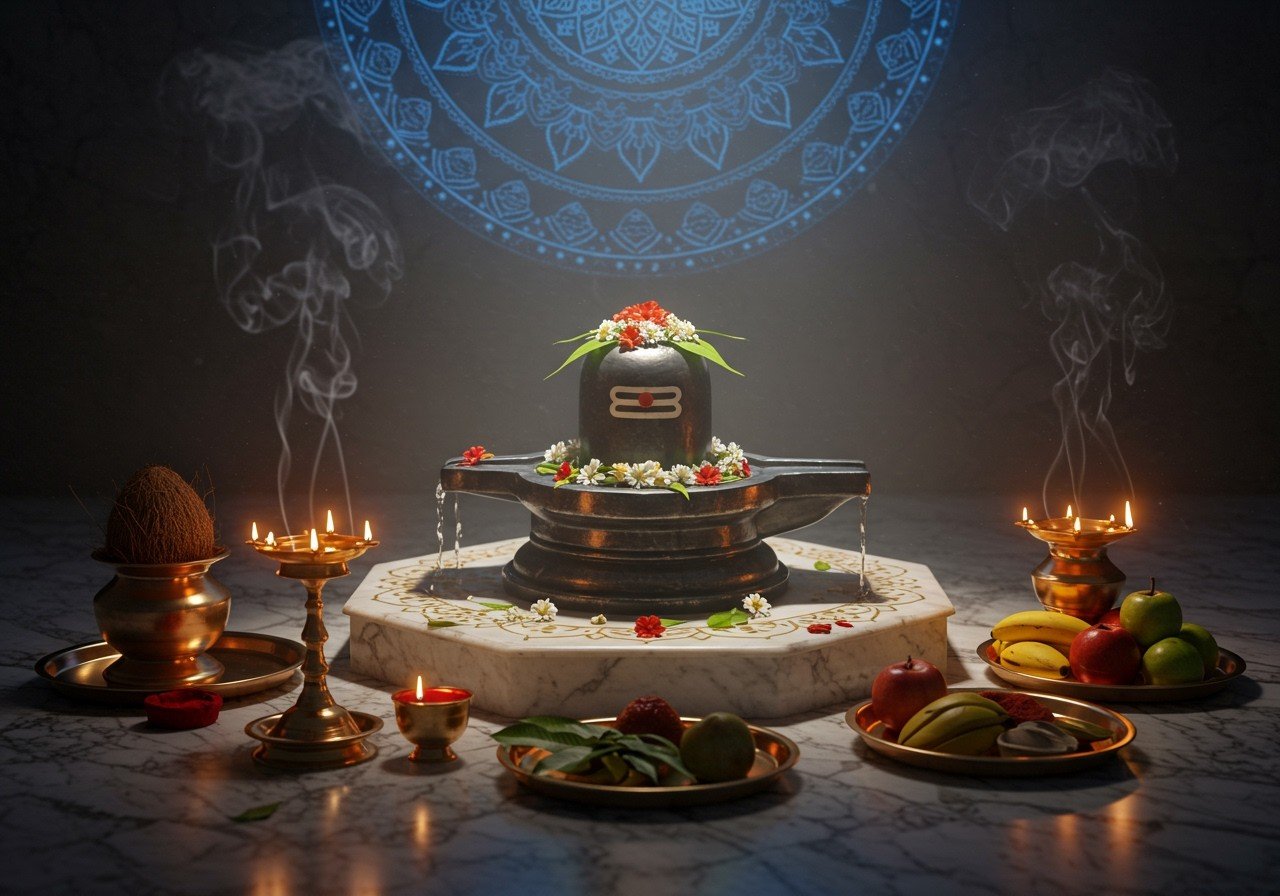
The spiritual practice of Shiva Puja holds a special place in Hindu tradition, a heartfelt tribute to Lord Shiva, revered as ‘The Destroyer’ within the divine Trinity. For many, performing Shiva Puja at home offers a beautiful way to connect with our spiritual heritage while navigating the rhythms of modern life. This sacred ritual is believed to dispel negativity, ushering in peace and prosperity. And with the convenience of online platforms, sourcing authentic puja items has become easier than ever.
Understanding the Significance of Shiva Puja
Shiva Puja is more than just a set of rituals; it’s a profound expression of reverence for Lord Shiva’s power, encompassing both destruction and regeneration. Central to this worship is the Shiva Linga, a symbolic representation of divine energy and the cosmos itself. Engaging in Shiva Puja can bring a sense of inner peace, mental clarity, and an influx of positive energy.
While some misunderstandings about Shiva Puja persist, it’s a pathway open to all, irrespective of background or belief. Among the various forms of Shiva worship, Rudra Abhishek and Maha Shivaratri Puja hold particular significance. Every offering, be it milk, the sacred bilva leaves, or pure water, carries deep symbolic meaning within the puja.
Preparing for Shiva Puja at Home: A Sacred Space
Creating a dedicated space for Shiva Puja at home transcends mere physical arrangement; it’s a spiritual undertaking, preparing both the environment and the individual for a deeper connection with the divine. Let’s explore the essential steps:
Cleanliness and Purity: Setting the Stage
Begin by selecting a quiet and clean area in your home, preferably facing east or north, directions associated with auspicious beginnings. Adorn the space with fresh flowers and a clean white cloth, symbolic of purity and devotion. Physical cleanliness mirrors the purity of mind and body we strive for.
Before commencing the puja, purify yourself with a bath. Choose clean, preferably white or light-colored attire, as these hues represent peace and clarity, setting the right intention for your worship.
Mental Preparation: Focusing the Mind
Find a comfortable seat and take a few moments to quiet your mind, bringing your focus to Lord Shiva. Gently release any worries or distractions, allowing yourself a brief period of meditation. This mental preparation is key to opening your heart and mind to divine energy. Learn more about the essentials of Shiva Puja.
Essential Puja Items: Gathering the Sacred Tools
Assemble the following items, each imbued with spiritual significance, to facilitate your puja:
- Shiva Lingam or Idol: The focal point of your devotion, representing Lord Shiva’s presence.
- Pure Water (Ideally Gangajal): Symbolizing purity and cleansing.
- Offerings of Nourishment: Raw milk, yogurt, honey, and ghee, signifying devotion and abundance.
- Sacred Leaves and Flowers: Bel Patra (Bilva leaves) and fresh flowers, traditionally offered to Lord Shiva.
- Fruits and Sweets: Symbols of gratitude and offerings of sweetness to the divine.
- Sacred Ash (Vibhuti): Representing the impermanence of material existence.
- Incense Sticks and Diyas: Purifying the atmosphere and symbolizing enlightenment.
- Rice Grains (Akshata): Representing prosperity and auspiciousness.
- Sandalwood Paste (Chandan): For anointing the deity and symbolizing fragrance and purity.
- Camphor (Kapoor): Used for aarti, signifying the burning away of negativity.
- Sugar and Jaggery: Representing sweetness and devotion.
- Betel Leaves and Nuts: Traditional offerings signifying respect.
- Mala (Garlands): Symbolizing devotion and connection to the divine.
- Sacred Thread (Moli): Representing protection and blessings.
- Coconut: Representing wholeness and auspicious beginnings.
- Puja Thali, Bell, Water Vessel, Plate for Offerings: Essential tools for performing the rituals.
- Incense Holder, Earthen or Brass Lamp: Practical items for holding incense and the diya.
- Oil and Cotton Wicks: For lighting the lamp, representing the dispelling of darkness.
- Panch Patra: A vessel for holding sacred water during the puja.
You can find many of these items and more at Poojn.in, India’s leading online store for puja samagri. We offer a wide selection of high-quality products to help you create a truly sacred space for your Shiva Puja.
Setting Up the Altar: Creating a Focal Point
Position the Shiva Lingam or idol at the center of your altar, ensuring it’s at a respectful height, ideally at eye level when seated. Arrange all the puja items neatly and respectfully around the central figure, making sure everything is within easy reach.
Performing Shiva Puja at Home: A Step-by-Step Guide
Performing Shiva Puja is a deeply fulfilling spiritual practice. Follow these steps to conduct the puja with reverence and devotion:
Invocation (Dhyan): Welcoming the Divine Presence
Begin by meditating and chanting mantras to invoke Lord Shiva’s presence. This sets the spiritual tone for the entire puja. Browse our collection of Shiva idols.
Lighting the Lamp and Incense: Illuminating the Sacred Space
Light the diya (lamp) and incense sticks. The light symbolizes knowledge and dispels darkness, while the fragrant incense purifies the atmosphere and helps focus the mind.Find high-quality diyas and incense sticks at Poojn.in.
Abhishekam (Ritual Bathing): Purifying the Divine Form
Perform Abhishekam by gently pouring water over the Shiva Lingam while chanting “Om Namah Shivaya.” You can also use other sacred substances like milk, honey, yogurt, and ghee, each with its symbolic meaning. Cleanse the Shiva Lingam with water after each offering.Find beautiful Shiva Lingams for your puja at Poojn.in.
Decoration and Offerings: Expressing Devotion
Apply sandalwood paste to the Shiva Lingam. Place three-leafed Bel leaves on the Lingam, ensuring the smooth side faces it. Offer fresh fruits, flowers, and sweets to Lord Shiva with heartfelt devotion.
Naivedyam and Chanting Mantras: Nourishment and Connection
Offer fruits and sweets as Naivedyam, placing them before the deity. Recite mantras dedicated to Lord Shiva, such as “Om Namah Shivaya” and the “Maha Mrityunjaya Mantra,” known for its healing and protective qualities.
Performing Aarti: A Ritual of Light and Gratitude
Light the camphor or aarti lamp and perform the aarti by circling it clockwise in front of the Shiva idol or Lingam while singing the aarti song. Ring the bell during the aarti. The resonant sound symbolizes the dispelling of ignorance and the awakening of consciousness.
Concluding Prayers and Meditation: Seeking Blessings
Offer your final salutations and conclude the puja with prayers and meditation. Reflect on your intentions for the puja and seek Lord Shiva’s blessings for peace, prosperity, and spiritual growth.
Daily Shiva Puja Practices: Integrating Devotion into Daily Life
Integrating Shiva Puja into your daily routine, even in small ways, can significantly enhance your spiritual journey. Simple acts like lighting a diya, offering water to the Shiva Lingam, and chanting mantras can bring a sense of peace and connection to the divine.
Maintain a personal altar with a Shiva Lingam or image for daily worship. Complement your puja with meditation and pranayama (breathing exercises) to deepen your devotional experience.
Overcoming Common Challenges in Shiva Puja
Limited Space? Create a portable altar on a small table or shelf, adapting the practice to your living situation. You can find a variety of compact and beautiful Shiva Lingams and idols here.
Time Constraints? Divide the puja into shorter segments throughout the day, integrating it into your schedule. Involve family members, especially children, to make it a shared spiritual experience.
Pronunciation Difficulties? Utilize audio guides or mantra translations to deepen your understanding and connect more deeply with the meaning of the chants.
Explore our collection of Shiva Murtis.
Don’t hesitate to seek guidance from knowledgeable individuals or spiritual communities to enrich your understanding and practice of Shiva Puja. You can find a helpful guide to performing Maha Shivaratri Puja at home here.
Embracing the Divine in Everyday Life through Shiva Puja
Shiva Puja is not merely a ritual; it’s a path of devotion and a source of inner peace. By embracing these practices, we invite Lord Shiva’s divine presence into our lives, filling our homes and hearts with tranquility and fostering spiritual growth. The journey of puja is as enriching as its destination, each step deepening our connection with the divine.
Whether you choose to perform an elaborate puja or a simple daily offering, the sincerity of your devotion is what truly matters. May the blessings of Lord Shiva guide you towards a life filled with inner peace and prosperity. With the convenience of online resources, access to authentic puja items is simpler than ever, allowing us to honor our traditions with ease and reverence.
FAQs on Shiva Puja at Home
How can I begin Shiva Puja at home if I’m new to this? Starting Shiva Puja at home is simpler than you might think. First, cleanse your puja area, creating a sacred space. Set up a small altar with a Shiva Lingam or an image of Lord Shiva. Light a diya and some incense sticks to purify the atmosphere and set a reverent mood. Even a small gesture done with sincerity is a beautiful beginning.
What essential items do I need for Shiva Puja? The core items for Shiva Puja include a Shiva Lingam or image, a diya, incense sticks, fresh flowers, bel leaves, milk or water, and a small bell. These help facilitate the rituals and express your devotion. You can find pre-assembled puja kits at Poojn.in that contain everything you need to get started. Visit us at poojn.in
Can I perform Shiva Puja at home every day? Absolutely, you can perform Shiva Puja daily. A simple daily practice might involve offering water or milk to the Shiva Lingam while chanting ‘Om Namah Shivaya.’ Even a few moments of daily connection can bring significant spiritual benefit.
When is the most auspicious time to perform Shiva Puja at home? Early morning, during Brahma Muhurta (typically an hour and a half before sunrise), is considered highly auspicious for Shiva Puja. The quiet stillness of this time enhances connection with the divine. Alternatively, evenings are also considered a good time for puja.
Could you guide me through the steps of performing Shiva Puja? Certainly. Begin by purifying the puja space and yourself. Offer water or milk to the Shiva Lingam, followed by fresh flowers and bel leaves. Light the diya and incense sticks. Finally, chant ‘Om Namah Shivaya’ with devotion and ring the bell softly. Each step carries symbolic meaning, deepening the connection with Lord Shiva.
What is the significance of the bel leaf in Shiva Puja? The bel leaf, or bilva leaf, holds special significance as it is believed to be particularly dear to Lord Shiva. Offering bel leaves during the puja is considered highly auspicious and is believed to bring his blessings.
Is it necessary to have a priest perform Shiva Puja at home? Not at all. With sincere devotion and the necessary items, you can conduct Shiva Puja yourself. Simple steps and heartfelt prayers are more than sufficient to connect with the divine. Follow the guidance in this blog or consult a guide like this one for a step-by-step guide.


